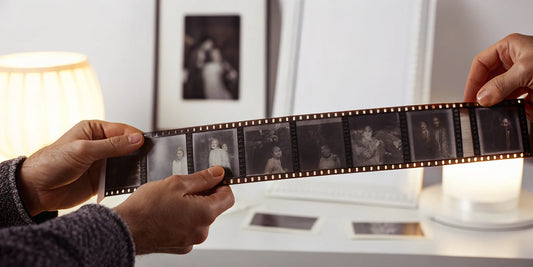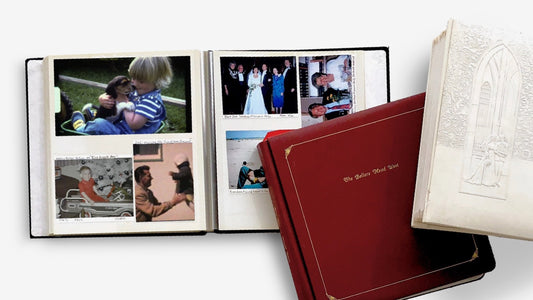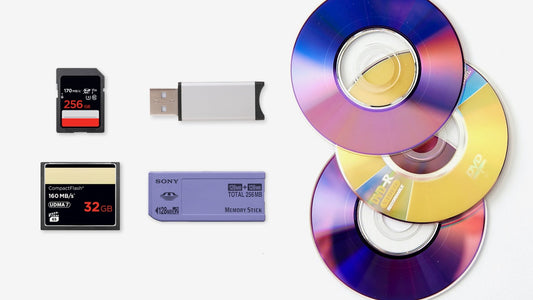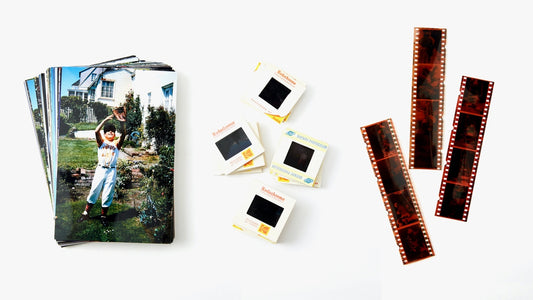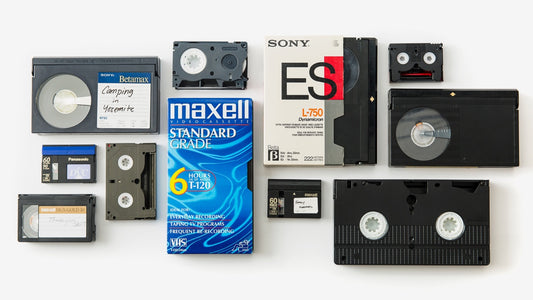Let's be honest, where are your most cherished family photos right now? If they're in a dusty attic box or a damp basement corner, they're in trouble. While these spots might seem harmless, they are often the worst places for your delicate prints. Extreme temperatures and humidity create the perfect environment for mold, fading, and decay, slowly erasing the memories you hold so dear. Protecting the physical prints is the first and most crucial step. This guide will show you exactly how to create the best storage for old photos to halt deterioration and keep your family’s history safe.
Key Takeaways
- Protect Your Prints from the Elements: The single most important step is proper physical storage. Use acid-free, archival-quality boxes and keep them in a stable, climate-controlled part of your home—like an interior closet—to prevent the damage caused by attics and basements.
- Create a Digital Archive for Safekeeping: Sorting your photos by year or event makes the collection manageable. Digitizing your prints is the best way to safeguard them against physical damage or loss and makes sharing those memories with family effortless.
- Make Preservation an Ongoing Habit: Photo care doesn't end after scanning. Establish a reliable digital backup system (like the 3-2-1 rule) and schedule a yearly check-up to ensure both your physical prints and digital files remain safe and accessible for the future.
Why Proper Storage for Old Photos Is a Must
Tucked away in shoeboxes and forgotten albums are pieces of your family’s history. These old photos are more than just paper; they're tangible links to the people and moments that shaped your life. But physical photos are fragile. Without the right care, these irreplaceable memories can fade, discolor, or be lost forever. Understanding why proper storage is so important is the first step toward protecting your family’s legacy for generations to come. It’s not just about organization—it’s about preservation.
What's Happening to Your Photos Over Time?
Printed photos, especially older ones, have a limited lifespan. The paper they’re printed on often contains acid, which causes it to become brittle and yellow over time. Think about how an old newspaper crumbles—the same process is happening to your pictures, just more slowly. Color photos are particularly vulnerable, as the dyes used to create the images can fade and shift. This deterioration is a natural chemical process, but it’s accelerated by poor storage conditions. You can slow this process way down, and a great way to stop it completely is through a professional photo transfer to a digital format.
How Print Quality Affects Longevity
Not all photo prints are created equal, and the materials used have a major impact on how long they'll stick around. Professional printing services often use specific, archival-quality papers designed to resist fading for over 100 years when stored properly. Unfortunately, many of our most treasured family snapshots weren't printed with that kind of longevity in mind. Think about those old photo albums with the sticky, clear-film pages—those adhesives often contain acid that can damage photos over time, causing discoloration and making them impossible to remove without tearing. Since you can’t go back and reprint those moments, the best way to preserve them as they are now is to create a digital backup before they degrade any further.
Why Your Family Photos Are Priceless
In an age of cloud storage, it’s easy to forget the unique power of a physical photograph. These prints are often the only copies of a specific moment, serving as a vital backup and a direct connection to family history. They hold stories that can’t be replicated. A handwritten note on the back or the specific texture of the photo paper adds a layer of history that a digital file alone can’t capture. It’s crucial to talk with older relatives about these photos now, capturing the names, dates, and stories before those precious details are lost forever.
Are You Making These Photo Storage Mistakes?
Many of us are accidentally damaging our photos with the best of intentions. The most common mistake is storing them in the wrong places, like basements, attics, or garages. These areas suffer from extreme temperature and humidity swings, creating the perfect environment for mold and decay. Another major culprit is the "magnetic" or peel-and-stick photo albums that were popular for decades. The acidic cardboard and glue used in these albums can cause severe discoloration over time. Finally, avoid using rubber bands, paper clips, and standard plastic bags, as these materials can release chemicals that will harm your photos.
Your Guide to the Right Photo Storage Materials
Choosing the right home for your photos is one of the most important steps you can take to preserve them. Everyday containers like shoeboxes or plastic bins might seem harmless, but they often contain chemicals that can cause your precious memories to fade, turn yellow, or become brittle over time. Investing in archival-quality materials is the best way to protect your photos from damage and ensure they last for generations to come.
Why Acid-Free Boxes and Albums Are Essential
When you see the term “acid-free,” pay attention. Most paper and cardboard products are made with wood pulp, which contains an acidic compound called lignin. Over time, this acid can leach into your photos, causing them to break down. To prevent this, look for special storage boxes or albums that are specifically labeled as acid-free and lignin-free. These archival-safe containers are designed to be chemically stable, creating a safe environment that helps your photographs remain in pristine condition for years. Think of them as a secure home where your memories can rest without the risk of chemical damage.
How Protective Sleeves Safeguard Your Prints
For an extra layer of defense, it’s a great idea to place individual photos in protective sleeves. These enclosures shield your prints from dust, fingerprints, and the minor scratches that can happen when photos rub against each other. Look for plastic sleeves made from polyester, polypropylene, or polyethylene, and make sure they do not contain PVC, which can release harmful chemicals. If you’re on a tight budget, simple plastic sandwich bags can work as a temporary, cheaper option. This simple step provides a crucial barrier against dust and physical wear, keeping each photo crisp and clean.
Using Mylar for Extra Protection
If you have photos that are particularly old, fragile, or just incredibly precious, Mylar sleeves offer a superior level of protection. Mylar, a specific type of polyester film, is exceptionally durable and resistant to moisture, creating a stable home for your prints. These enclosures are fantastic for shielding your photos from dust, fingerprints, and the minor scuffs that can happen when prints rub against each other. It’s crucial to choose Mylar sleeves that are free from harmful additives, as some plastics can release chemicals that damage photos over time. Always look for sleeves specifically labeled as "archival-quality" to ensure they won’t cause harm. Investing in the right materials is the best way to protect your photos from damage, providing a powerful barrier against environmental factors and physical wear to keep your family’s history safe.
Steer Clear: Materials That Can Ruin Your Photos
Knowing what to avoid is just as important as knowing what to use. Steer clear of common household items that can actively harm your photos. Regular plastic boxes and wrap often contain chemicals that accelerate deterioration. The same goes for shoeboxes, which are typically made with acidic cardboard and glues. Rubber bands are another enemy; they can decay over time, stick to your photos, and leave behind a stubborn residue. Paper clips can scratch the surface of your prints, and tape or sticky notes can leave behind adhesives that are nearly impossible to remove without causing damage.
Picking the Perfect Photo Storage Containers
Ultimately, the best strategy is to invest in containers specifically designed for photographic preservation. While that old shoebox might seem convenient, its materials can cause irreversible harm. Instead, opt for boxes that are clearly marked as being free of acid and lignin. These archival boxes create a safe, stable environment that won't yellow or damage your photos. You can find them at craft stores or online from specialty archival suppliers. Making this small investment now is one of the most effective ways to ensure your family’s visual history remains vibrant and intact for the future.
Archival Boxes vs. Plastic Bins
When you’re deciding how to store your family photos, the container you choose makes a huge difference. It’s tempting to grab a plastic bin from the garage, but those containers often release chemicals that can speed up how fast your prints break down. Even seemingly innocent shoeboxes can cause your precious memories to fade or turn yellow over time. What seems like a simple storage solution can actually be doing more harm than good, slowly damaging the very photos you’re trying to protect.
This is where archival-quality materials come in. Investing in proper storage is the best way to make sure your photos last for generations. Archival boxes are made to be acid-free and lignin-free, which means they create a safe, neutral environment that won't harm your prints. Think of them as a secure home for your memories, free from the hidden dangers of everyday containers. It’s a simple switch that helps keep your photographs in the best possible condition.
Remember, regular plastic boxes and even the cardboard in shoeboxes contain acids and glues that can cause irreversible damage to your photos. These chemicals can leach into your prints over time, leading to discoloration and decay. By choosing archival boxes instead, you’re making a small investment that makes a big difference. It’s a proactive step that ensures your family’s visual history stays vibrant and safe for everyone to enjoy for years to come.
How to Create the Perfect Environment for Your Photos
Once you have the right containers, the next step is finding the perfect spot to store them. The environment where your photos live is just as important as the boxes they’re in. Photos are sensitive to their surroundings, and things like temperature, humidity, and light can cause irreversible damage over time. Creating a stable, safe home for your collection is one of the most effective things you can do to protect it. The goal is consistency—a place that stays cool, dark, and dry all year round. This simple step prevents the slow decay that can erase your most precious memories.
Finding the Sweet Spot: Temperature and Humidity
Think of your photos like a person who’s comfortable in a cozy room—they don’t like extremes. The key is to find a place where the temperature and moisture stay steady. Big swings from hot to cold or damp to dry cause the delicate layers of a photograph to expand and contract, leading to cracks, brittleness, and peeling. Ideally, you want a spot that stays below 75°F with a relative humidity between 30% and 40%. This stable climate helps prevent mold growth and chemical decay, keeping your images clear and intact for years to come.
Keep Them in the Dark: Managing Light Exposure
Light is one of the biggest enemies of old photos. Exposure to any light, but especially direct sunlight or fluorescent lighting, will cause the colors in your pictures to fade dramatically. The UV rays break down the chemical makeup of the photograph, leaving you with washed-out, discolored images. The best way to protect them is to keep them in complete darkness. Storing them inside an acid-free box, which is then placed inside a closet or a cabinet, provides multiple layers of light protection. This is why digitizing your collection through a photo transfer is such a great idea—you can display the digital copies without ever risking the originals.
The Best (and Worst) Places to Store Your Photos
Not all storage spots are created equal. You should absolutely avoid storing photos in attics, garages, or basements. These areas are prone to extreme temperature fluctuations and high humidity, creating the perfect storm for photo damage. They’re also more susceptible to pests and potential water damage. Instead, look for a climate-controlled area inside your main living space. An interior closet, a shelf in a spare room, or even a drawer under your bed are all excellent choices. These locations are buffered from outside weather changes and maintain a much more stable environment year-round.
A Simple Way to Monitor Your Storage Space
You don’t have to guess whether your chosen spot is safe for your photos. For a small investment, you can get a clear picture of the conditions. A simple digital hygrometer, which measures both temperature and humidity, can be placed right next to your photo boxes. Check it every few months to make sure the levels are staying within a safe range. If you notice the humidity creeping up during certain seasons, you can add a desiccant pack (the little silica gel packets) to your storage box to absorb excess moisture. This little bit of monitoring goes a long way in proactive photo care.
How to Finally Organize Your Photo Collection
Once you have the right storage materials, the next step is to get your photos in order. Organizing your collection does more than just tidy up a closet; it turns a pile of pictures into a story you can easily share and revisit. Taking the time to sort and label your photos now will make them easier to enjoy for years to come. It also makes the process much smoother if you decide to digitize them later. A little prep work goes a long way in preserving your family’s history.
First, Curate Your Collection
The first step, and maybe the hardest, is to decide what to keep. It’s tempting to save every single picture, but that can leave you with an overwhelming collection. Before you start sorting into categories, simply create two piles: "Keep" and "Toss." Go through each photo and make a quick decision. A "keeper" is a photo that tells a story—one with clear faces, from an important event, or that just makes you smile. It's okay to let go of the blurry shots, the endless landscapes, and the pictures of people you don't recognize. If you find duplicates of a favorite photo, offer the extras to family members before tossing them. This process isn't about getting rid of memories; it's about curating the best ones so they can truly shine.
The Right Way to Handle Old Photos
Before you start sorting, it’s important to remember that old photos are delicate. The oils on your skin can cause permanent damage to the photo emulsion over time. To keep them safe, try to handle your photos as little as possible. When you do pick them up, hold them by the edges and consider wearing clean cotton gloves for an extra layer of protection. Set up a clean, dry workspace away from food and drinks. This simple step ensures your memories stay in great condition while you organize them.
Handling Photos with Cotton Gloves
While holding photos by the edges is a great first step, wearing clean cotton gloves takes your preservation game to the next level. It might feel a little formal, but there’s a good reason archivists do it. The natural oils and lotions on our hands can leave behind invisible residues that cause permanent stains and chemical damage over time. This professional tip, recommended by experts at the National Archives, is one of the easiest ways to ensure your photos stay pristine. Keeping your prints clean doesn't just help them last longer; it also ensures you get the best possible quality when you're ready for a digital archive. Every fingerprint can show up in a high-resolution scan, so by handling them carefully now, you're preserving every detail for a future photo transfer. You can find inexpensive cotton gloves at most craft stores, making this an accessible step for anyone serious about protecting their family history.
Sorting Your Photos: By Date or by Event?
Tackling a giant box of photos can feel overwhelming, so start by creating a system. Sorting your photos makes them much easier to find later and helps piece together your family’s timeline. You can group them chronologically by year or decade, or sort them by specific events like holidays, vacations, and birthdays. Don’t worry about getting it perfect on the first try. Start with broad categories and then break them down further. This is especially helpful if you have photo albums you want to preserve through album scanning, as it keeps the original context intact.
A Simple Guide to Labeling Your Photos
A picture might be worth a thousand words, but a few key details can make it priceless. Future generations will want to know who is in the photos, where they were taken, and when. Gently write on the back of each photo with a photo-safe pencil or pen—avoid ballpoint pens or markers that can bleed through or indent the image. Include names, approximate dates, and the location or occasion. Adding this context turns a simple photograph into a cherished family artifact, full of stories waiting to be told.
Safe Labeling with Pencils and Index Cards
While it’s tempting to grab the nearest ballpoint pen, the ink can bleed through the paper over time or create indentations that permanently damage the front of the image. For a safer option, use a soft, No. 2 pencil to gently write on the back. Pencil lead is archival-safe and won't harm the photo. An even better method is to avoid writing on the photo altogether. Instead, jot down the details on a separate, acid-free index card. You can then slip the card behind the photo inside its protective sleeve. This approach keeps the original print completely clean while ensuring its story is never lost, providing all the context without any of the risk.
How to Make Any Photo Easy to Find
After all your hard work sorting and labeling, the final step is to make your collection accessible. Use acid-free dividers to separate different years or events within your storage boxes. You can label the outside of each box with a general description of what’s inside, like “Childhood Photos: 1985-1995” or “Family Reunions.” For larger collections, you might even create a simple inventory list. This way, when you want to find a specific memory or send a batch for a photo transfer service, you’ll know exactly where to look without having to search through every single box.
Digitize Your Photos for Safekeeping
Creating digital copies is one of the best ways to safeguard your photos against damage and loss. A digital archive acts as a permanent backup, ensuring your memories are safe even if the original prints fade or get damaged. Plus, it makes sharing those precious moments with family and friends incredibly easy. While you can tackle this as a DIY project, it does take time and the right equipment to get great results. If you'd rather leave it to the experts, a professional photo transfer service can handle the entire process for you, delivering high-quality digital files without the hassle.
How to Choose the Right Scanner
If you decide to scan your photos yourself, your scanner will be your most important tool. For the best quality, a flatbed scanner is ideal, as it allows you to carefully place each photo and capture fine details. If you have hundreds or thousands of photos, a sheet-fed scanner can be a huge time-saver, but be sure to choose one designed for photos to avoid damaging your originals. Look for a scanner that can capture images at a resolution of at least 600 DPI (dots per inch). This ensures your digital copies will be clear and sharp enough to print without looking pixelated.
Our Top Tips for Scanning Photos
A little prep work goes a long way. Before you begin, sort your photos by event or year. This will not only streamline the scanning process but also make it much easier to organize the digital files later. Gently wipe each photo and the scanner glass with a clean, lint-free microfiber cloth to remove any dust or fingerprints that could show up in your scans. When you’re ready to scan, check your scanner’s settings. For the most accurate colors, use the Adobe RGB (1998) color space for color photos and Grayscale Gamma 2.2 for black-and-white images.
Which File Format Should You Use?
The file format you choose determines the quality and size of your digital images. For archival purposes, TIFF is the gold standard. It’s a “lossless” format, meaning it preserves all the original image data, resulting in the highest possible quality. The downside is that TIFF files are very large. For everyday use, like sharing on social media or emailing family, JPEG is a great option. It creates smaller, more manageable files. A good strategy is to scan and save your photos as TIFF files for safekeeping, then create JPEG copies for easy sharing.
Setting Up a Fail-Proof Backup System
Your work isn’t done once the scanning is complete. To truly protect your digital photo collection, you need a solid backup plan. A single hard drive isn’t enough—drives can fail, get lost, or be damaged. A great guideline to follow is the 3-2-1 backup rule: keep at least three copies of your photos, on two different types of storage media, with one copy stored off-site. For example, you could save your photos on your computer’s internal hard drive, an external hard drive, and a cloud storage service like Google Photos or Dropbox. This way, your memories are protected from almost any disaster.
Organizing Your Digital Files with Metadata
Once your photos are scanned, a good folder structure is your best friend. Start by creating main folders for each year, then subfolders for specific events like “Summer Vacation 2004” or “Grandma’s 80th Birthday.” This keeps everything tidy and intuitive. To take it a step further, you can add metadata—or tags—directly to your image files. This is hidden information like names, dates, and locations that gets embedded in the file itself. Most photo viewing software lets you edit this information, and it makes your collection searchable. Imagine typing “Aunt Carol” and instantly finding every photo she’s in. It’s like creating a digital version of the handwritten notes on the back of old prints.
Understanding Cloud Storage Capacity
Your off-site backup will likely be a cloud storage service. Think of it as a secure online home for your photos. Services like Dropbox or Google Photos are great options, but it’s important to understand their capacity. Many offer a small amount of free storage to get you started—for example, Dropbox gives you 2 GB for free. However, high-quality photo scans, especially TIFF files, can take up a lot of space. You’ll likely need a paid plan, which can offer 2 terabytes (TB) or more—enough room for hundreds of thousands of photos. It’s a small monthly investment that provides huge peace of mind, knowing your memories are safe from local disasters like a fire or flood.
Printing Digital Photos as a Backup
It might seem counterintuitive, but one of the best ways to back up your new digital collection is to create new physical prints. As one expert from Southern Living notes, "Digital files can get lost or corrupted... so having physical copies is a good backup." You don’t need to reprint everything. Instead, curate a small album of your absolute favorite and most important photos from your newly digitized collection. This creates a high-quality, acid-free heirloom that your family can enjoy without having to power up a device. It brings the preservation process full circle, giving you a tangible treasure to pass down through the generations.
When to Call in the Professionals
Digitizing your photos yourself can be a rewarding project, but it’s not always the best fit. Sometimes, the sheer volume, delicate condition of your photos, or the need for high-quality results makes calling a professional the smartest move. Trusting your memories to an expert can save you time, prevent accidental damage, and give you a beautiful digital archive you can treasure and share for years to come. Here’s how to know when it’s time to get help and what to look for in a service.
Signs It's Time to Hire a Pro
If you're staring at boxes overflowing with photos, the sheer volume might be your first sign. A professional service is built to handle thousands of images efficiently. You should also consider an expert if your photos are particularly fragile, damaged, or historically significant. Old photos with tears, fading, or discoloration require a delicate touch and specialized equipment to scan without causing further harm. The same goes for unique formats like slides, negatives, or entire photo albums with pictures stuck to the pages. If the thought of handling these irreplaceable memories feels overwhelming, it’s a good idea to let a professional take the lead.
How to Choose a Digitization Service
Not all digitization services are created equal. When you’re trusting someone with your family’s history, you want to know they’re in good hands. Look for a company that is transparent about its process. Ask how they handle your original photos and what steps they take to keep them safe. A reputable service will use high-quality scanners and offer options for color correction and restoration. Don’t be afraid to check reviews and ask for samples of their work. A trustworthy photo transfer service will gladly walk you through their entire process, from the moment your photos arrive to how they’re returned to you.
What to Expect When You Hire a Service
Handing over your photos can feel a bit nerve-wracking, so knowing what happens next is key. The process typically begins with your photos being carefully scanned at a high resolution to capture every detail. This applies to loose prints as well as more complex jobs like album scanning, where each page is digitized with precision. From there, technicians can often make edits to enhance the quality, correcting colors that have faded and removing minor imperfections. Once everything is digitized, you’ll receive your files in an easy-to-use format, like on a USB or in a private cloud account. Your original photos should be returned to you along with your new digital copies, ready for you to share.
Long-Term Care for Your Photo Collection
Preserving your photos isn’t a one-time project; it’s an ongoing commitment. Once you’ve organized, stored, and digitized your collection, a little regular maintenance will ensure your memories stay safe for generations. Think of it like a regular check-up for your family’s history. By creating a simple routine, you can catch potential issues before they become big problems and keep both your physical prints and digital files in great shape. This final step is all about creating a sustainable system that protects your hard work and, more importantly, the precious moments you’ve saved.
Your Simple Photo Maintenance Schedule
The best way to stay on top of photo care is to put it on the calendar. Pick a day once or twice a year—maybe on a significant family anniversary or during a quiet season—to check on your collection. During this time, you’ll want to inspect the physical storage conditions and verify your digital backups. Before you even think about scanning, it's a good idea to get organized. Sorting your photos by date or event can make the whole process feel less overwhelming and helps you spot if anything is missing. This schedule also gives you a dedicated time to digitize any new photos you’ve acquired, ensuring your photo transfer project is always up to date.
Your Photo Care Toolkit
Having the right tools on hand makes maintenance quick and easy. For your physical photos, keep a small kit with cotton gloves to prevent fingerprints, a soft-bristled brush for dusting off prints, and extra acid-free sleeves or dividers. For your digital collection, the main tool is your scanner. If you choose to scan at home, invest in a good one that can handle stacks of photos quickly and at a high resolution. Alternatively, specialized photo-scanning apps on your phone can be a great option for quick jobs. If you have delicate or oversized items, consider a professional album scanning service to ensure they are handled with care.
Preparing Your Photos for the Unexpected
Life is full of surprises, and not all of them are good. It’s wise to have a plan for protecting your photos from unexpected events like floods, fires, or even just a major leak. Store your physical photos in a location that’s elevated and away from potential water sources. For digital files, the biggest threat is hardware failure. That’s why having multiple backups is non-negotiable. Use a combination of a physical external hard drive and a cloud storage service. This creates redundancy, so if one system fails, your memories are still safe. Services that handle digital media transfer can help you consolidate files from old drives and discs, making your backup process much simpler.
How to Do a Quick Quality Check
During your scheduled maintenance, take a close look at both your physical and digital photos. For prints, check for any signs of fading, yellowing, brittleness, or moisture damage like mold or mildew. Look for any insect activity in your storage boxes. For your digital files, the check is just as important. Open a few random files from your backups to make sure they aren’t corrupted and are still accessible. When you’re digitizing new photos, simple steps like de-skewing the images so they’re straight can make a huge difference in the final quality. Catching these small issues early is the key to preventing the permanent loss of a cherished memory.
Related Articles
- 5 Ways to Convert Negatives to Digital – YesVideo
- How to Digitize Photos: A Complete Guide – YesVideo
- 8 Best Digitizing Services Reviewed for 2025 – YesVideo
Frequently Asked Questions
I have boxes and boxes of photos. Where do I even begin? Feeling overwhelmed is completely normal, so the key is to start small. Don't try to tackle the entire collection at once. Pick one album or one shoebox to begin with. Your first goal is simply to sort the photos into broad categories, like by decade or by major life event. This simple step makes the project feel much more manageable and sets you up for success when you're ready to store or digitize them.
My photos are stuck in those old "magnetic" albums. Is it safe to remove them? You need to be very careful with these albums, as the acidic glue can cause photos to become brittle and permanently attached. Forcing them out will likely cause tearing. You can try gently sliding a piece of dental floss under the edge of a photo to see if it will lift the adhesive. If there's any resistance or if the photos are especially precious, it's best to leave them to a professional who has the right tools to safely remove and scan them.
If I can only do one thing right now to protect my photos, what should it be? The single most important thing you can do is move your photos to a better environment. Get them out of the attic, basement, or garage immediately. These places have wild temperature and humidity swings that accelerate decay. Find a spot inside your main living area, like a closet in a spare bedroom, where the climate is stable. This one move can dramatically slow down the aging process.
Is it better to scan my photos myself or use a professional service? This really depends on your time, equipment, and the size of your collection. Scanning at home can be a great project if you have a small number of photos and a good-quality flatbed scanner. However, if you have hundreds or thousands of images, or if your photos are fragile, a professional service is often the better choice. They have specialized equipment to produce high-quality digital files efficiently and can handle delicate originals with expert care.
Once my photos are digital, are they completely safe? Digital files are a fantastic backup, but they aren't automatically permanent. A hard drive can fail and cloud services can have issues. The safest approach is to have multiple copies in different places. A good rule of thumb is to keep one copy on your computer or an external hard drive and another copy with a cloud storage service. This ensures that even if one copy is lost or damaged, your family's memories are still secure.



